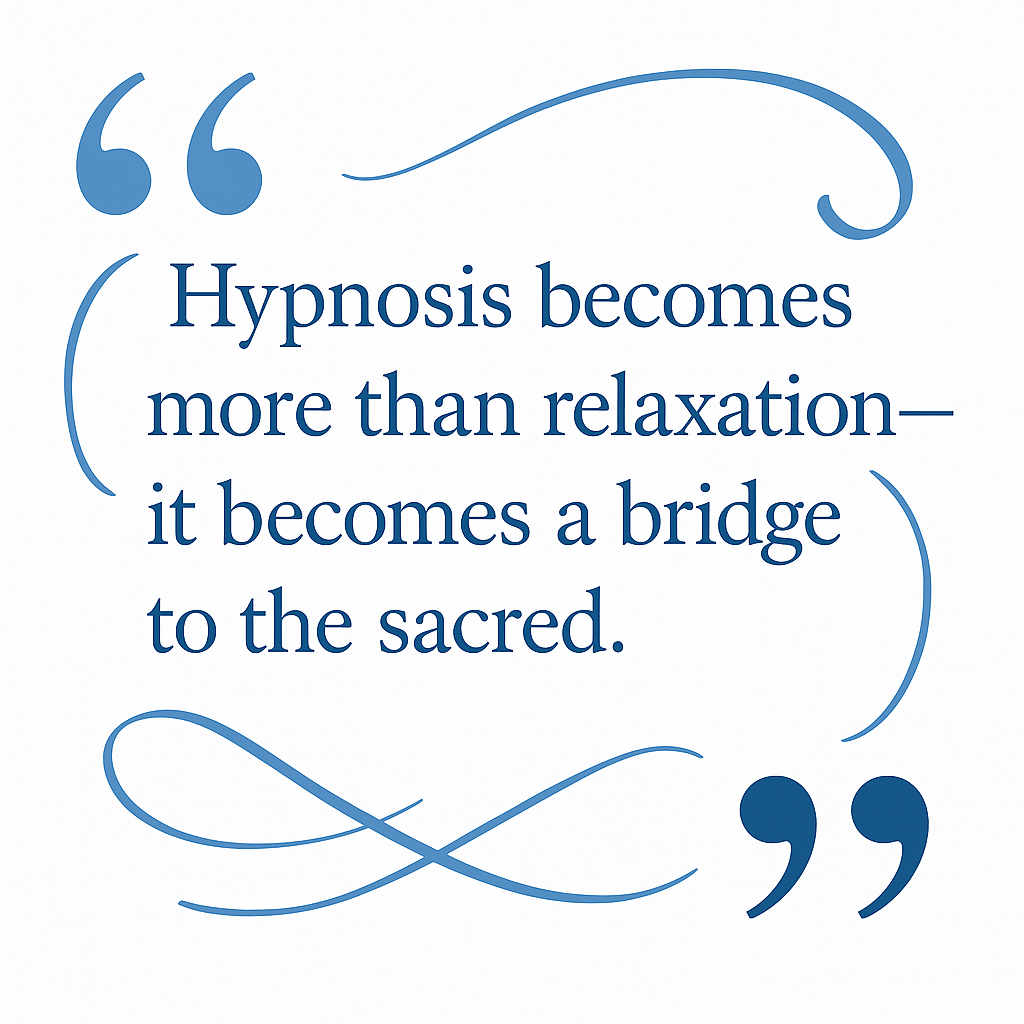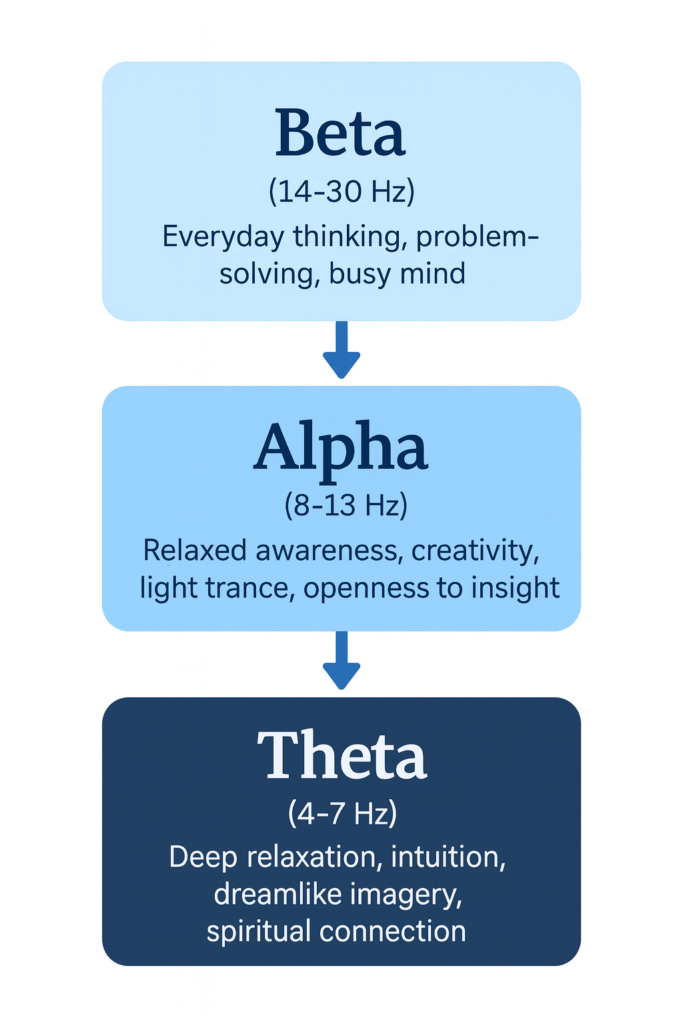At its heart, hypnosis is a natural state of focused awareness and deep relaxation. You’re not asleep, and you’re never under anyone’s control—in fact, most people feel more in touch with their inner world than ever before. In this state, the conscious mind softens, allowing the subconscious and even spiritual awareness to come forward in ways that feel safe and supportive.
Spirituality, meanwhile, is about connection. For some, it’s a relationship with their higher self. For others, it may be divine wisdom, Spirit, or the universal energy that ties everything together. However you define it, spirituality brings meaning, direction, and a sense of belonging that goes beyond the everyday self.
When these two paths come together, hypnosis becomes more than relaxation or stress relief—it becomes a bridge to the sacred. People often describe feeling a stronger sense of inner peace, encountering guides or spiritual beings, receiving insights about their life purpose, or seeing symbolic visions that carry deep meaning. As Psychology Today explains, hypnosis allows people to enter states of mind where they can explore questions of meaning and existence, which are at the very core of spirituality itself.
From my own perspective as a practitioner, I see hypnosis as a gentle and safe way to open the door to spiritual wisdom. Spirit only reveals what supports your healing in this lifetime, never more than you’re ready for. That’s why the experience often feels like a guided journey back to yourself—back to your soul’s deeper truth. If you’d like to explore how this process unfolds in more detail, I share additional insights in my Past Life Regression Hypnosis Guide, where hypnosis helps people connect with spiritual lessons across lifetimes.

Why Hypnosis Supports Spiritual Connection
One of the reasons hypnosis and spirituality work so well together is that hypnosis quiets the constant chatter of the conscious mind. When that mental noise softens, space opens for deeper awareness—an awareness that many describe as spiritual. In this state, you may feel closer to your higher self, sense the presence of a guide, or even experience symbolic imagery that answers questions you’ve been carrying.
Science helps explain why this happens. Research shows that hypnosis creates states similar to meditation, which is already a proven path to spiritual awakening. According to Psychology Today, hypnosis can help people tap into a spiritual state of mind, allowing them to process meaning and cope with existential questions. In other words, hypnosis makes it easier to step into the quiet place where Spirit can be heard.
I’ve witnessed this many times in my sessions. One client came to me during a difficult life transition. Under hypnosis, she described seeing a warm light surrounding her, and while no words were spoken, she felt comforted by a presence that seemed to guide her forward. That single experience shifted the way she approached her challenges. Instead of feeling alone, she felt supported—and she carried that feeling with her long after the session.
What I love most about this process is that Spirit only reveals what’s supportive for your growth. There’s no forcing, no rushing—just gentle guidance. Some clients receive vivid imagery, others sense energy or emotion, and some simply feel peace they haven’t known in years. All of these are forms of spiritual connection, and hypnosis provides the opening to receive them.
For a similar perspective, you can explore how I describe the process of uncovering soul lessons in Past Life Regression Therapy, which uses hypnosis to reveal meaningful spiritual patterns across lifetimes.
The Science of Hypnosis and Spirituality
While hypnosis feels deeply spiritual, there’s also a scientific explanation for why it opens the door to higher awareness. When you enter a hypnotic state, your brainwaves naturally shift. Instead of staying in the fast-paced, alert rhythms of everyday life, your brain slows into patterns that mirror deep meditation and prayer.
Most of the time, we operate in beta brainwaves—the state of problem-solving, planning, and analyzing. It’s useful for getting things done, but it can also be noisy and distracting. As you relax, you enter alpha brainwaves, where your mind becomes calmer, more creative, and more open to subtle impressions. Go deeper still, and you reach theta brainwaves, a dreamlike state where intuition, imagination, and spiritual connection flow more freely.
This explains why hypnosis feels like a bridge between the mind and Spirit. By guiding you into alpha and theta states, hypnosis helps you access the same mental space where profound spiritual experiences often occur.
Here’s a simple way to understand the brainwave connection:

When clients reach theta during hypnosis, they often describe feeling as though they’ve stepped into another layer of themselves. It’s in this space that spiritual messages, symbolic visions, and a sense of connection to something greater naturally emerge.
Hypnosis vs Other Spiritual Tools
People often ask me how hypnosis compares to practices like meditation or prayer. The truth is, they all bring us closer to Spirit, but in slightly different ways. Meditation helps quiet the mind through stillness and breath. Prayer focuses attention outward, toward a higher power. Hypnosis blends the two—using guided imagery and suggestion to open a channel to both the subconscious and the spiritual.
Here’s a simple way to see the difference:
| Practice | Main Focus | Common Spiritual Experience |
|---|---|---|
| Meditation | Breath, stillness | Peace, presence, expanded awareness |
| Prayer | Higher power, devotion | Comfort, guidance, connection |
| Hypnosis | Imagery + suggestion | Symbolic visions, spiritual insight, guide encounters |
What makes hypnosis unique is the co-creative nature of the process. You bring your intention—whether that’s connecting with your higher self, seeking guidance, or releasing a block—and hypnosis provides the relaxed, receptive state to help it unfold. In many ways, it’s like meditation with a flashlight: you can shine your focus directly where you most want clarity.
I often see clients who already have strong meditation or prayer practices, but they come to hypnosis when they want to go deeper, faster, or with more direction. One client who had meditated for years told me that hypnosis felt like “meditation on fast-forward”—she was able to access the spiritual insight she had been seeking for months in a single session.
If you’d like to see another way hypnosis works as a spiritual tool, I share more examples in Hypnosis for Spiritual Growth.
Client Stories: Hypnosis as a Spiritual Pathway
Nothing explains the connection between hypnosis and spirituality better than real experiences. Each session is different, but they all show how Spirit reveals just what someone needs at that moment.
One woman came to me feeling lost after a major life change. During hypnosis, she saw herself standing on a path lined with light. A gentle presence appeared beside her and placed a key in her hand. She didn’t hear words, but the symbolism was powerful—she later realized it was about trusting herself to unlock new doors in life. That single vision gave her the courage to step forward in a direction she had been resisting.
Another client struggled with a constant sense of guilt he couldn’t explain. In hypnosis, he experienced a past life where he had abandoned responsibilities, leaving him burdened with regret. In that safe space, he was able to forgive himself. When he came out of the session, he said he felt lighter, as though a weight he’d been carrying for decades had finally lifted.
Not all experiences are dramatic—sometimes Spirit simply offers peace. A client once described lying in a warm light, with no visions or guides, just the overwhelming comfort of knowing she was supported. That calm stayed with her for weeks and helped her through difficult times.
These stories highlight something important: hypnosis doesn’t force spiritual experiences. It gently opens a door, and Spirit decides what comes through. Whether it’s a symbolic vision, a connection with a guide, or simply peace, the experience is always meaningful and aligned with what supports healing.
For more examples of how hypnosis reveals soul patterns, you can explore Signs of Past Life Connections.
Tarot Break ~ Click the Card for a Tarot Reading
Before clicking the card, ask Spirit what message do you need right now. You can then Start Chat to ask a question about the reading. An AI-Chatbot will respond based on the card.

Safety, Ethics, and Spiritual Respect
Because hypnosis and spirituality touch such a deep part of who we are, it’s important to approach the process with care. Hypnosis is safe when guided by a trained professional like me, but like any spiritual practice, it requires intention, respect, and boundaries.
As the Cleveland Clinic explains, hypnosis is non-invasive and supportive, especially when practiced responsibly. You remain in control the entire time, fully aware and able to choose how far you want to go. It’s not about surrendering your will—it’s about creating a safe container where you can relax, explore, and receive.
In spiritual hypnosis, I always emphasize that Spirit reveals only what is most supportive for your healing and growth. Nothing is forced. If you don’t see or feel something in one session, it simply means Spirit is preparing you in another way. The process is never about performance—it’s about presence.
Ethically, it’s also important to honor each person’s spiritual framework. Some clients may feel comfortable describing their experiences in terms of God, angels, or guides, while others may relate more to energy, intuition, or universal wisdom. All of these perspectives are valid, and the role of the hypnotherapist is to support, not to impose.
I also believe in grounding every session. After a spiritual experience, I guide clients back into the present moment, helping them integrate what they’ve learned. This way, the insights don’t just feel mystical—they become practical tools for healing and daily life.
If you’d like to learn more about how I guide this process, you can read my Past Life Regression Hypnosis Guide, which explains how to prepare for deep spiritual sessions safely.
Final Thoughts on Hypnosis and Spirituality
When we bring hypnosis and spirituality together, we open a doorway into something profound. Hypnosis quiets the mind so that Spirit, the higher self, or the universe can be felt more clearly. Whether it comes through as a vision, a presence, or simply peace, the experience often feels like coming home to yourself.
What makes hypnosis unique is its ability to combine intention with deep relaxation. You don’t need to “try harder” or force a spiritual experience—Spirit reveals only what supports your healing and growth. That’s why so many describe spiritual hypnosis as transformative.
If you’re ready to explore this for yourself, I invite you to learn more about my spiritual hypnosis services. Together, we can create a safe, supportive space for your journey inward.
Frequently Asked Questions About Hypnosis and Spirituality
Can hypnosis help with spiritual awakening?
Yes. Hypnosis quiets the mind and opens the subconscious, which makes it easier to connect with your higher self and experience new levels of spiritual awareness.
Is hypnosis safe for spiritual exploration?
Absolutely. According to the Cleveland Clinic, hypnosis is safe when practiced by a trained professional. You remain in control at all times.
How is hypnosis different from meditation or prayer?
Meditation focuses on stillness and presence, prayer on devotion and guidance, while hypnosis uses guided imagery and suggestion to create direct access to spiritual insight.
Will I meet spirit guides during hypnosis?
Many people do. Some experience guides as vivid imagery or symbolic figures, while others feel their presence through emotion, energy, or light. Every connection is unique and meaningful.
What if I don’t see or feel anything spiritual in hypnosis?
That’s okay. Sometimes Spirit works subtly. Even a session that feels quiet can bring healing, clarity, or emotional release that unfolds over time.


